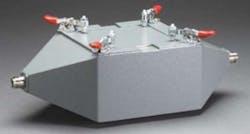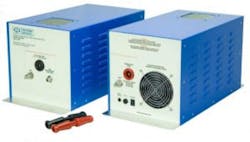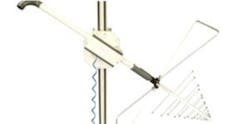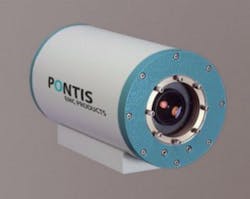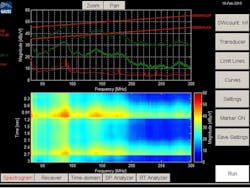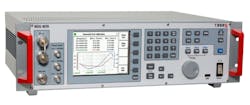Improving your EMC test experience
EMC PRODUCT FOCUS
Recent advancements in EMC-related products take many forms from DSP-based signal processing to higher frequency TEM cells to shielded video cameras. A major theme is ease of use, which may be provided through greater integration, higher speed, or smaller size.
Rather than measuring EUT emissions at a succession of frequencies, a receiver that performs short-term FFTs can simultaneously measure up to 16,000 points, significantly speeding up the process. And, because signal complexity and variability continue to increase, capabilities, such as real-time spectrum analysis, that don’t miss important events have become both more available and necessary.
Smaller, more efficient amplifiers
The W Series air-cooled RF class A amplifiers have been redesigned to be smaller, quieter, and more efficient than previous versions. Power output extends from 250 W in the 250W1000B to 4,000 W in the 4000W1000B and is covered by a total of six models at 250 W, 500 W, 1,000 W, 1,500 W, 2,000 W, and 4,000 W. The 80-MHz to 1,000-MHz frequency range and the capability to operate without damage or oscillation into any load impedance are common for all models.
These broadband, completely solid-state amplifiers feature flat gain, a low noise figure, and high harmonic rejection. Each model can deliver 100% of rated output power without foldback. Protection is provided by DC current level sensing of all output stages.
A digital control panel indicates both forward and reflected power as well as amplifier status. Remote operation via GPIB/IEEE 488, RS-232, USB, and Ethernet is supported. AR RF/Microwave
Instrumentation
Extended frequency range TEM cell
The FCC-TEM-JM5 TEM cell increases the maximum operating frequency of the company’s range of TEM cells from 2,500 MHz to 3,000 MHz. Other models in the series have upper frequency limits of 1,200 MHz, 1,600 MHz, and 2,000 MHz. All five models can be used for emissions and immunity testing of integrated circuits.
The IC is mounted on a standardized test fixture that clamps in place. For all the cells, the maximum DUT volume is 6 cm x 6 cm x 1 cm. With the IC fixture installed, measurements per IEC 61967-2, SAE 1752-3, and IEC 62132-8 can be performed to the cell’s upper frequency limit. When the FCC-TEM-JM5 is used for immunity testing, less than 3.7-mW input power is required to achieve a 10-V/m electric field and less than 37 W for a 1,000-V/m field.
Type N RF connectors are used at both ends of the cells, which measure 15 cm x 10 cm x 34 cm overall. The maximum VSWR for the three higher frequency cells is 1.25:1 and 1.2:1 for the other two. The maximum input power is 500 W for all cells. Fischer Custom Communications
With a 100-A AC-current rating and maximum 440-V AC line-to-ground voltage, the LI-1100 line impedance stabilization network (LISN) significantly increases the power level of the manufacturer’s conducted emissions CISPR 16-1-2/ANSI C63.4-compliant, 150-kHz to 30-MHz test solutions. The LI-1100 includes two separately housed, single-conductor networks to be installed in series with each current-carrying conductor in a single-phase, dual-phase, or DC power system. An additional two networks in a second LI-1100 can accommodate three-phase power systems.
This LISN uses air-core inductors to prevent saturation and permeability variation. The mounting plate of the LI-1100 is left unpainted to facilitate connection to earth ground, which is essential because of high leakage current. Com-Power
Remote-controlled antenna mast
The MA4000-XP-ET mast uses a shielded and RFI-suppressed drive unit to position an antenna weighing up to 8 kg (or optionally 10 kg) at heights from 1.0 m to 4.0 m with an accuracy of ±3 mm. When the mast is combined with the company’s MP2200 mast positioner, three independently controllable axes of motion are provided. Compliant with CISPR 16-1-4 boresight requirements, the mast achieves polarization accuracy of ±0.1 degree over a range of 0 through 90 degrees. All antennas rotate around their own axis during polarization to eliminate any elevation errors. And, the antenna can be tilted from 0 to 45 degrees at a speed of 7.5 degrees/s while maintaining ±0.5-degree accuracy.
All metal parts are located in the base plate and drive mechanism, with no metal at heights above 0.4 m. Control is via a fiber-optic cable link to the controller. Limit switches and the general mechanical design ensure safe system operation. Temperature range is 10°C to 40°C, maximum input current is 1.6 A, and the mast can be powered from a 115-V, 60-Hz or a 230-V, 50-Hz supply. innco systems
EMC hardened color camera
Radiated immunity testing stresses the equipment under test to determine if it can withstand high field strengths over a large frequency range. For the EUT to pass the test, no permanent damage can occur, but a temporary disturbance of the normal operation may be allowed. If the EUT includes a display, it must be monitored during the test by a camera.
The compact PONTIS Cam8 camera is purpose designed for this application and provides 670 horizontal PAL or NTSC lines with automatic focus and white balance. The motorized x40 optical zoom is complemented by an additional x12 digital zoom. Control inputs and video output are via 50/125-µm glass fiber with ST connections. Weighing 2 kg and measuring 190-mm long x 100-mm diameter, the camera is shielded for use in fields up to 200 V/m in strength and meets the CISPR 25 Class 5 requirement from 150 kHz to 2 GHz.
PONTIS EMC products are made in Germany and are available from HV Technologies in the United States. PONTIS EMC
Real-time spectrum analysis
Real-time spectrum analysis (RTSA) is available as the RT1 option for the manufacturer’s N9038A MXE EMI receiver. With the option, you can observe and diagnose transient and wideband emissions during EMC testing. Fast, short-duration signals commonly encountered in radar, automotive, and wireless communications testing are difficult to capture with conventional spectrum or signal analyzers.
The MXE in RTSA mode provides a real-time analysis bandwidth up to 85 MHz for carrier frequencies below 3.6 GHz and up to 40 MHz for carriers higher than 3.6 GHz. 100% probability of capture is guaranteed for signals persisting at least 3.7 µs.
Frequency mask trigger capability is included and operates on signals of at least 17.4-µs duration. The RTSA option can be added to new and existing MXE EMI receivers as well as the manufacturer’s UXA, PXA, and MXA X-Series signal analyzers. Keysight Technologies
Automated disturbance power measurement
The manufacturer’s TDEMI eXtreme (TDEMI X) instrument has a 325-MHz instantaneous bandwidth and a 100-dB dynamic range. In receiver mode, it provides a fully compliant short-term FFT implementation, which greatly speeds up EMC measurements. The TDEMI X has a 9-kHz lower frequency limit, extendable to 10 Hz by option MIL/DO-UG, and upper frequency limits of 1 GHz, 3 GHz, 6 GHz, 18 GHz, 26.5 GHz, and 40 GHz.
The TDEMI X simultaneously measures power in the 30-MHz to 300-MHz range at up to 16,000 frequencies in a fully CISPR-compliant real-time spectrogram mode as an absorbing clamp is continuously moved over the full length of the slideway. In addition, the TDEMI-X frequency mask trigger will compare the measurement to the limit line in real time and automatically trigger if the limit is exceeded. Gauss Instruments GmbH
Compact field generator
For your next EMC immunity test, rather than combining a signal generator, power amplifier, and suitable antenna, you could use the EMField generator. A single cable couples external DC power (up to 8 A at 50 V), a low-level version of the desired output, and control signals to the generator from the company’s EMCenter controller.
Internally, the input signal is boosted and applied to a compact antenna. The EMField product emphases field strength instead of power. Up to six amplifiers, each with its own antenna, handle the signal. The overall output field strength is achieved by directly combining the fields from several small antennas, not by attempting to electrically combine the amplifier outputs and then drive one large antenna.
The generator is available with a 10-V/m field strength at 3-m distance and weighs 11 kg or in a 9-kg version with a 3-V/m rating. ETS-Lindgren
Low-frequency test system
For low-frequency disturbance testing from 15 Hz to 150 kHz, the Model NSG 4060 immunity test system complies with a wide range of standards: EN 61326-3-1, IEC 61850-3, IEC 60255-22-7, IEC 60533/IEC 60945, IEC 61000-4-16, and IEC 61000-4-19. The system includes a signal generator with an integrated power amplifier as well as ports for system and network control and phase synchronization input.
Each unit includes two USB inputs; analog, digital, and optical EUT monitoring inputs; and an external modulation input. A user manual with extensive setup diagrams and instructions also is provided. TESEQ


